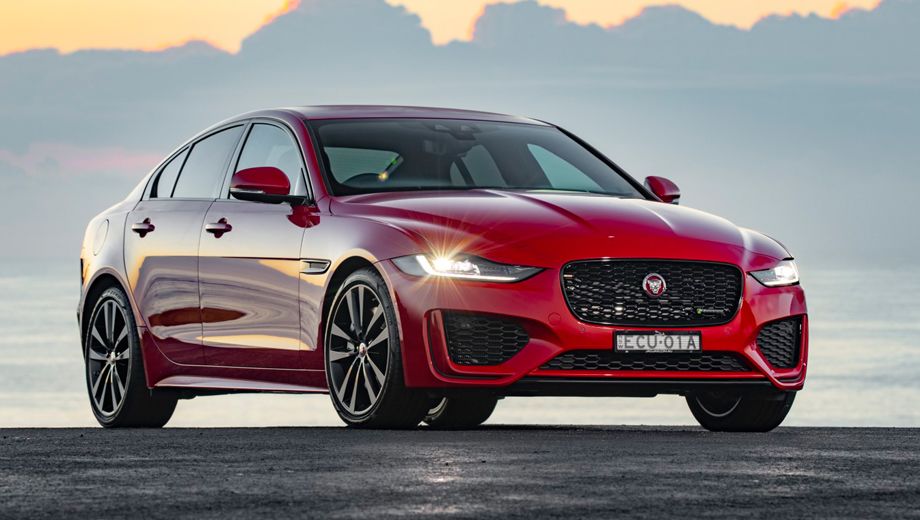Road test: the Jaguar XE is an executive express
With the updated XE, the British-born prestige brand puts up a worthy challenge to its German rivals.

Between Jaguar-Land Rover’s various brands (Jaguar, Land Rover and Range Rover), the Indian-owned British-based manufacturer is doing its best to keep pace with its relentless Germans rivals.
The Jaguar XE was launched in 2015 to rival the likes of Audi’s A4, BMW’s 3 Series and Mercedes-Benz’s C-Class; now comes a facelifted 2020 incarnation.
This includes significant tech upgrades plus some modest styling changes, along with simplification of the model range; down from 14 variants to just two, the SE and HSE.
A quick update
Both are powered by the same 2.0-litre, four-cylinder turbo sending power to the rear hoops via a classy eight-speed auto.
It’s a proven engine you’ll find deployed across JLR’s portfolio, delivering a competitive 221kW and 400Nm launching the XE R-Dynamic HSE model we’re testing ($71,940 RRP, $82,320 as tested) to 100km/h in a brisk 5.9 seconds.
By comparison, the BMW 330i ($70,900) musters 190kW/400Nm and utilises an eight-speed auto to achieve its claimed 5.8 sec to 100km/h; while over at Mercedes-Benz, this sort of money will tip you into a C300 ($71,800) with nine-speed auto, boasting 190kW/370Nm and an identical 0-100km/h split of 5.9 secs.
In short, the XE is bang on the money in terms of matching its competitors in the power and performance stakes.
When it comes to styling, the XE is a handsome car with a great stance, attractive proportions and fine detailing. As such, there’s wasn’t a lot that needed changing, although Jaguar has taken the opportunity to add a sportier front bumper with enlarged air inlets, as well as new LED headlights and tail-lights.
Inside is where many of the major changes have been wrought, with the addition on HSE variants of JLR’s Touchpro Duo infotainment system, and a twin-screen setup that mimics what’s now found on other models in the Brit maker’s range.
That means a 10.2-inch touchscreen with navigation and a load of other features, atop a smaller screen that manages the digital climate control settings. The system now also includes Apple CarPlay/Android Auto, which was unavailable on the previous model.
Gear change
One change some aficionados may lament is the loss of the rotary automatic gear selector, which previously emerged theatrically from the centre console on start-up. It’s been replaced by a more conventional (and intuitive) stick shift lever with four selectable drive modes.
In terms of kit, the base SE model comes equipped with features including lane keep assist, autonomous emergency braking, rear traffic monitor, auto high-beam, a 360-degree parking monitor and reversing camera. The HSE adds the twin-screen multimedia system, blind spot assist, adaptive cruise and an 11-speaker 380W Meridian Sound System, among other goodies.
Our XE HSE was also fitted with a range of optional extras including the Premium Interior Pack ($1010), Dynamic Handling Pack ($2090), sliding panoramic sunroof ($1900), technology pack ($1710), black exterior pack ($840), 16-way electric driver memory front seat ($650), privacy glass ($650), heated front seats ($620), 40-20-40 split fold rear seat with armrest ($460) and powered bootlid ($450). All up that lot adds $10,380 to the XE’s list price.
The overall colour theme in our test car was a sombre black, although there are just enough splashes of meshed aluminium trim, bright metal pedals and metal tread plates to break up the bleakness. The configurable ambient lighting also enables selection of attractive cabin mood lighting.
The driving position is low and comfortable, the driver nestled into perforated Windsor leather seats, while gripping a chunky R-Dynamic-branded leather steering wheel.
Front seat accommodation gives little cause for complaint, but rear seat passengers aren’t as well looked after with a lack of foot, knee and headroom. The rear seat is also fixed, meaning limited flexibility unless you option the 40-20-40 split fold setup ($460).
The driving experience
Out on the road, the XE is impressively quiet and comfortable with a compliant ride and keen handling. The steering is nicely weighted and consistent, the XE darting eagerly into bends, exhibiting excellent body control and overall composure when pushed.
Jaguar claims that 75 per cent of the XE’s body is aluminium, keeping weight to a respectable 1633kg with tangible benefits in terms of ride and handling. So too the optional Dynamic Handling Pack, which groups adaptive dampers with larger brakes and the ability to customise engine, gearbox and steering settings.
The mid-sized executive sedan was more or less invented by the Germans, and Audi, BMW and Mercedes-Benz retain a stranglehold on the category. Given added competition from the likes of Genesis, Infiniti and Lexus, Jaguar has its work cut out to get on the radar of buyers, let alone put a dent in the Germans’ market share.
But for those buyers who make the time to take a look at the Jaguar XE, they’ll find a classy and compelling proposition that is one of the most dynamically capable sedans in its class.
.jpg)
.jpg)
.jpg)
.jpg)
.jpg)
.jpg)
.jpg)
.jpg)

Qantas - Qantas Frequent Flyer
02 Jul 2011
Total posts 1378
This class of mid-sized ICE cars is going to get smashed by the Tesla Model 3.
Virgin Australia - Velocity Rewards
24 Aug 2011
Total posts 785
Maybe, but in two to three years time the Chinese will have a Model 3-beater.
Hi Guest, join in the discussion on Road test: the Jaguar XE is an executive express